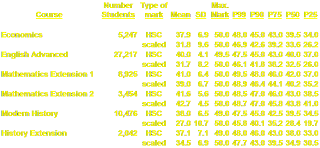The High School Certificate (HSC) is a certificate awarded to High School leavers and issued by the NSW Board of Studies (BOS). It marks the completion of 13 years of schooling (K-12), presents a profile of the student's academic achievements and is the gateway to further tertiary education and employment.
To be eligible for an HSC, a student must:
. complete satisfactorily at least 12 units of HSC courses in the Preliminary year (Year 11) and at least 10 units of HSC courses in the HSC year (Year 12)
. complete satisfactorily assessment tasks mandated by the individual school for each course
. sit for the HSC examinations with the rest of the state in the HSC year.
The HSC courses to be selected must include:
. 2 units of English
. at least 6 units of Board Developed courses
. 3 courses of 2 units or greater
. 4 subjects (A subject is an area of study which may have several different courses. e.g. within the subject English, courses include English Standard, English Advanced, English Extension 1 and English Extension 2).
HSC courses are mostly worth 2 units (100 marks) while some, including Extension courses are worth 1 unit (50 marks), indicating relatively the amount of effort and time needed to be spent in the course. As a general guideline, a 1-unit value represents class time of approximately 2 hours per week (60 hours per year). Examples of non-extension 1-unit and 2-unit courses include.
Course Subject Unit
Studies of Religion I Studies of Religion 1
Studies of Religion II Studies of Religion 2
Extension Courses
In general, extension courses are of 1-unit value (except Mathematics Extension 1 and Mathematics Extension 2). They must be taken in conjunction with the corresponding 2-unit courses. In addition, some other rules also apply:
1. there are 3 2-unit English courses: English (ESL), English (Standard) and English (Advanced). However, English Extension 1 (1-unit) has to be taken in conjunction with English (Advanced) only. English Extension 2 (1-unit) has to be taken in conjunction with English (Advanced) and English Extension 1.
2. there are 2 2-unit Mathematics courses: General Mathematics and Mathematics. However, Mathematics Extension 1 has to be taken in conjunction with Mathematics only. Mathematics Extension 2 (which is the only extension course with 2 units) has to be taken in conjunction with Mathematics Extension 1.
Mathematics Extension 1, when taken with Mathematics (2-unit) is regarded as 1 unit. When taken with Mathematics Extension 2 (2-unit), it is regarded as 2 units.
3. there are 2 2-unit Music courses: Music 1 and Music 2. However, Music Extension (1-unit) has to be taken in conjunction with Music 2 only.
4. History Extension (1-unit) can be taken in conjunction with either Ancient History (2-unit) or Modern History (2-unit).
5. The Language Extension courses (1-unit) e.g. French Extension etc. have to be taken in conjunction with the corresponding Language Continuers courses (2-unit) e.g. French Continuers etc.
HSC courses are either Board Developed courses or Board Endorsed courses.
Board Developed courses are set and examined by the BOS, which also contribute to the calculation of the ATAR (hence also known as ATAR courses). They are classified as either Category A or Category B courses. Category A courses are academically intensive which require in-depth knowledge to provide sufficient background for tertairy studies. Category B courses do not provide an adequate background for tertiary studies, but they can contribute to the ATAR when combined with Category A courses. Examples of Board Developed courses (ATAR courses) in 2013 include:
Category A courses
Course Subject Unit
Agriculture Agriculture 2
English Standard English 2
English Advanced English 2
English Extension 1 English 1
English Extension 2 English 1
Legal Studies Legal Studies 2
Category B courses
Hospitality Hospitality 2
Human Services Human Services 2
Board Endorsed courses are courses developed by schools, TAFE or universities and endorsed by the BOS to cater for areas of special interests not covered in Board Developed courses. They count towards the HSC, but do not count towards the calculation of ATAR. Examples of Board Endorsed courses in 2013 include:
Course Subject Unit
Advertising Media Advertising Media 2
Desktop Publishing Desktop Publishing 2
To be eligible for an ATAR, a student must complete satisfactorily at least 10 units of ATAR courses including at least:
. 2 units of English
. 8 units of Category A courses
. 3 ATAR courses (Category A or B) of 2 units or greater
. 4 subjects.
In order to continue the study for tertiary education, a student has to select the required numbers of units of ATAR courses of his interest for study in Year 11 and Year 12, complete satifactorily assessment tasks for each course and sit for the open HSC examinations in Year 12 with the rest of the state.








